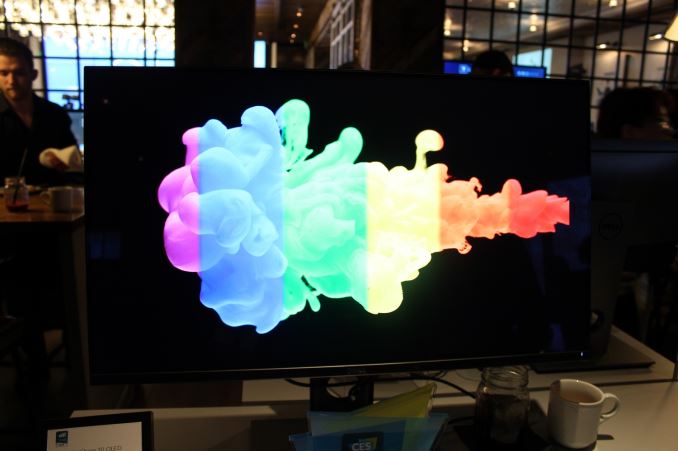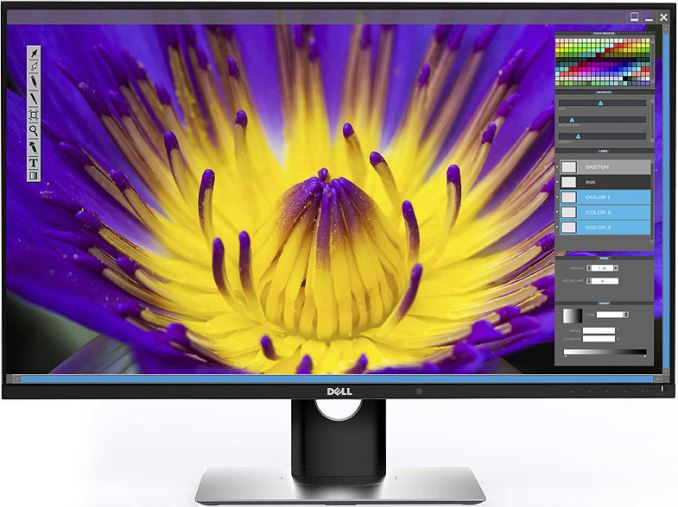Dell Demonstrates 30-inch 4K OLED Display
by Anton Shilov on January 7, 2016 6:40 PM EST- Posted in
- Monitors
- Dell
- Trade Shows
- 4K
- Ultrasharp
- CES 2016
- 30"
- OLED
- UP3017Q

Dell does not produce its own display panels, but when it comes to unique “world’s first” monitors, it is sometimes years ahead of all of its rivals. At the International CES 2016, Dell introduced its UltraSharp 30-inch OLED display, the company’s first monitor to use organic light emitting diode panel. The product is designed for professionals and carries a rather extreme price tag, but this is going to be a dream display for years to come.
The Dell UltraSharp UP3017Q is a 30-inch display with 3840×2160 resolution, 0.1 ms response time and an unknown refresh rate (yet, it should be very high). The monitor can reproduce 1.07 billion colors, it covers 100% of Adobe RGB color space as well as and 97.8% of DCI-P3 color space (used for digital movie projection by the U.S. movie industry and is expected to be adopted in televisions and in home cinema), according to Dell. Just a few professional displays nowadays cover 100% of Adobe RGB. The manufacturer declares 400,000:1 dynamic contrast ratio, but admits the value is only that because testing equipment won't go higher.
The UltraSharp UP3017Q ultra-high-definition display has very narrow bezels; the monitor itself is thin, but not remarkably thin like OLED TVs, possibly because it features internal power supply unit as well as complex logic inside. The monitor features a mini DisplayPort (mDP) connector, an HDMI port as well as a USB type-C port, which could be used for video and data connectivity as well as for power delivery (it can be powered using a type-C cable, or deliver power to another device).
Emissive electroluminescent layer in organic light-emitting diode is made of organic compound that emits light in response to an electric current. The organic semiconductor layer is situated between two electrodes and does not require a backlight. As a result, it can display truly deep black levels, unlike liquid crystal display (LCD) panels, which use various kinds of backlighting. Besides, since the emissive electroluminescent layer is very thin and can take different shapes, it is possible to build ultra-thin and even curved monitors and TVs using OLEDs.
While OLED technology can deliver deep blacks, high contrast ratio and exceptional colours, it is not free of drawbacks. The organic layer may burn down over prolonged amount of time, and colors can shift over time. To maximize lifespan of the OLED panel inside the UltraSharp UP3017Q, Dell integrated a special presence detector into the front panel of the display, which switches the monitor off when nobody uses it. Another disadvantage of OLEDs is a possibility of static image burn in. To reduce the chance of burn in, the UP3017Q has a special pixel-shifting technology.
The Dell UltraSharp 30 OLED monitor will cost whopping $4,999, which it becomes available on March 31, 2016, in the United States. The display at this point is only aimed at professionals, who work in color-critical environments such as graphic arts and photography. However, due to exceptional colors and contrast as well as ultra-fast response time, the UltraSharp UP3017Q will be a dream display for gamers, prosumers and other users, who value quality.
OLED panels are considerably more expensive to produce than modern LCD panels, partly because of lower yields. Last year an executive from LG Electronics said that yields of OLED panels had reached 80% and would continue to grow. At the International CES 2016, Kwon Bong-suk, the head of LG’s TV business, said that the company had cut prices of OLED TVs in the U.S. by 45% late in 2015. As a result, LG now expects sales of OLED televisions to triple this year. Price reduction of OLED TVs indicates that production costs of organic light-emitting diode panels are going down. Perhaps, over time, the Dell UltraSharp UP3017Q will also become more affordable, or Dell will release an OLED display for a wider audience.











83 Comments
View All Comments
lilmoe - Thursday, January 7, 2016 - link
"For what size panel?"I'm pretty certain he was talking about TVs, which is 48"+
iwod - Thursday, January 7, 2016 - link
Pretty much every normal size you would expect from Phone to TV. LG WOLED, while technically, or i should say theoretically speaking inferior to the way Samsung does OLED, do provide 90% of OLED benefits at 30% of the cost.I dont think i can tell the difference of the extra color space provided.
Sancus - Thursday, January 7, 2016 - link
Dell claims this is 120hz but it's not clear what connectivity options allow that refresh rate. Is this going to support Displayport 1.3?Guspaz - Friday, January 8, 2016 - link
They state HDMI and USB-C, which is DisplayPort. DisplayPort 1.3 can do 4K120. It'll take all four USB 3.1 lanes to do it, though, so the only other things running on that cable at the same time would be USB 2.0 and the 100W of power.Sancus - Friday, January 8, 2016 - link
Sure, that's my point. This is supposed to come out in March, but no video cards and no products support DP1.3 -- so it's very unclear how exactly you are supposed to run this monitor at 4K@120hz. If this is gonna be a DP1.3 monitor it would be nice to know that explicitly, and it'd also be nice to know where a DP1.3 video card is going to come from and when.DanNeely - Friday, January 8, 2016 - link
Dual DP1.2 cabling (similar to the current status for 5k60) would be a fallback option for 4k120. OTOH it's possible that only DP1.3 will unlock 120hz mode and that this will be a case where the monitor is out before the GPU capable of driving it at max settings. How big a deal that is comes down to if Pascal and Arctic Islands end up supporting DP1.3 or not. Assuming that they do, a few months of timing mismatch isn't a product killer.Nintendo Maniac 64 - Thursday, January 7, 2016 - link
Considering that a black pixel is an "off" pixel, wouldn't the static contrast and dynamic contrast on an OLED display be exactly the same?az060693 - Thursday, January 7, 2016 - link
I'm happy OLED is finally taking off but this would present some interesting problems in real-world usage. OLED doesn't seem to do very well with grays and shadow detail, and the burn-in is a bigger concern on desktops than tv's, with static elements like the taskbar constantly present. Pretty curious to see a review of this when it's out.MTEK - Friday, January 8, 2016 - link
Exactly. The user presence sensor seems like a hack, and the pixel shifting logic raises other questions, like, is it noticeable? I can go long hours with application toolbars just sitting there, not moving.Murloc - Friday, January 8, 2016 - link
maybe they bank on pixel density being high enough to not make it noticeable?